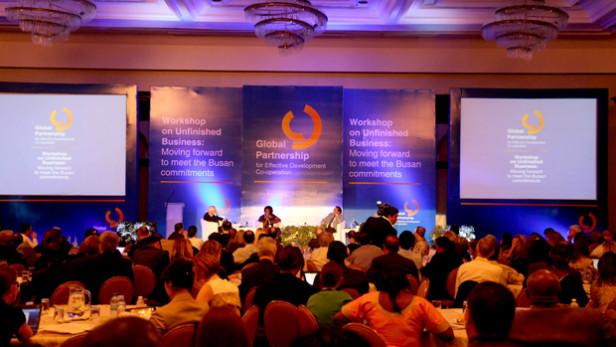This week, representatives of governments, donors and civil society organizations met in Mexico City to review progress towards “more effective development cooperation.” I’ve been following such discussions since I attended the IATI steering committee meeting as an observer, when the transparency standard was agreed upon in 2011. The question on my mind is how much has or has not changed since then. How wide is the transparency mandate likely to be following the Mexico meeting of the Global Partnership for Effective Development Cooperation (GPEDC)?

The Global Partnerships for Effective Development Cooperation meetings took place in Mexico City April 15 and 16. Courtesy photo: Matthew Taylor / Global Partnerships for Effective Development Cooperation
The development landscape is changing and our expectations for a transparency regime must similarly evolve. New donor countries are playing an increasingly prominent role, and there are more diverse forms of financing for development than ever before. In this post, I look at the role of officially supported export credits and the need for greater transparency of all development finance, not just aid.
Prior to the Busan High Level Forum in 2011, with these trends in mind, Michael Hubbard and I argued for the “widening of the transparency regime” to include all public flows for development, specifically not only official development assistance but also export credits. Twenty-one days later, the High Level Forum’s third draft outcome document mentioned publicly funded development activities for the first time. Initially, I saw this as a transparency coup, but my enthusiasm quickly faded. The final Busan outcome document diluted the transparency mandate for export credits with a loophole that made their disclosure “subject to legitimate concerns about commercially sensitive information.”
This fuzzy mandate left several key details up in the air as to the status of export credits in a post Busan transparency era. Are officially supported export credits acknowledged as ‘public flows’ or not? Should these export credits be considered as a form of financing for development and classified as a ‘publicly funded development activity’? Do officially supported export credits fall under the mandate of international aid transparency standard secretariat? The answers to these questions are complex and currently debated.
‘Publicly funded development activities’ that fall under the category of ‘official development assistance’ (ODA) adhere to a higher transparency standard via the OECD creditors reporting system. Officially supported export credits form part of ‘other official flows’ (OOF) and are not as transparent as the ODA. Therefore, the public has access only to disaggregated information for official development assistance and not for official direct export credits. Despite the fact that officially supported export credits are an important form of finance for development, IATI was not given a mandate for export credit transparency because these data are considered to be confidential.
Transparency at a Crossroads: Standards, Definitions and InstitutionsCountries such as China and India are emerging as a new cohort of export credit providers investing in the development of other countries in the form of South-South Cooperation. These southern providers do not acknowledge the definitions and reporting standards of the OECD’s Development Assistance Committee (DAC). It is not yet clear, however, if UN DESA working with southern providers will be able to broker a consensus on an alternative set of standards.
South-South Cooperation providers do consider export credits to be an instrument of development finance and whatever determination DAC donors make regarding a transparency standard for this financial flow type will have implications for South-South development cooperation. It is yet to be seen how a discussion of export credit transparencywould play out between OECD DAC donors and non-DAC providers of development finance, especially China and India. It's also unclear whether the consensus will be reached in international forums like GPEDC or UNDCF. Both India and China are not party to the OECD arrangement on export credits, and the issue touches upon a traditional fault line of development through trade versus aid.
While donors may view export credits from a purely commercial lens, recipient countries often apply these towards developmental and end up contracting sovereign debt. If we are to have a transparency regime that serves recipients, disclosure of export credits is critical.
ConclusionUntil the status of officially supported export credits is clarified as a ‘publicly funded development activity,’ the GPEDC’s transparency mandate will remain unclear. If development finance is indeed a global collective action, then there should be public disclosure and collective scrutiny of export credits to assess sovereign lending and borrowing practices, as well as implications of competition between providers of export credit. While I applaud Norway’s efforts to undertake a debt audit, if we are to push for a wider transparency mandate, we need to explore ways to make real time disclosure of export credits by all donors (DAC and non-DAC) politically plausible.

